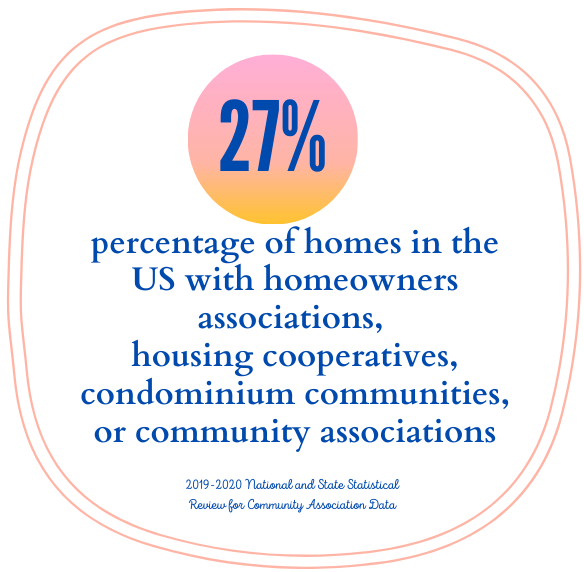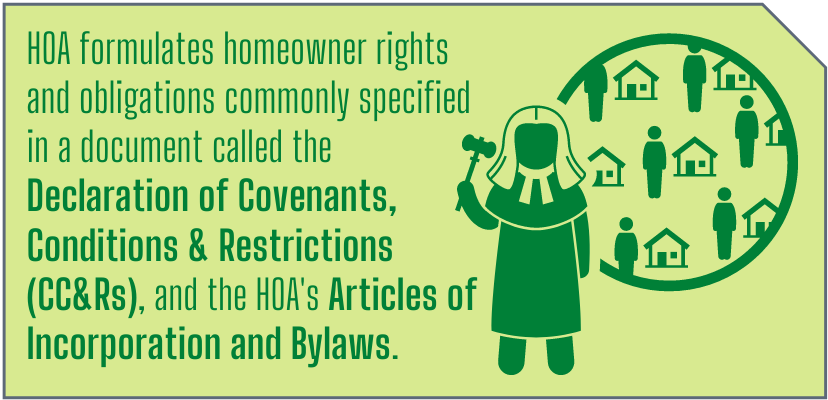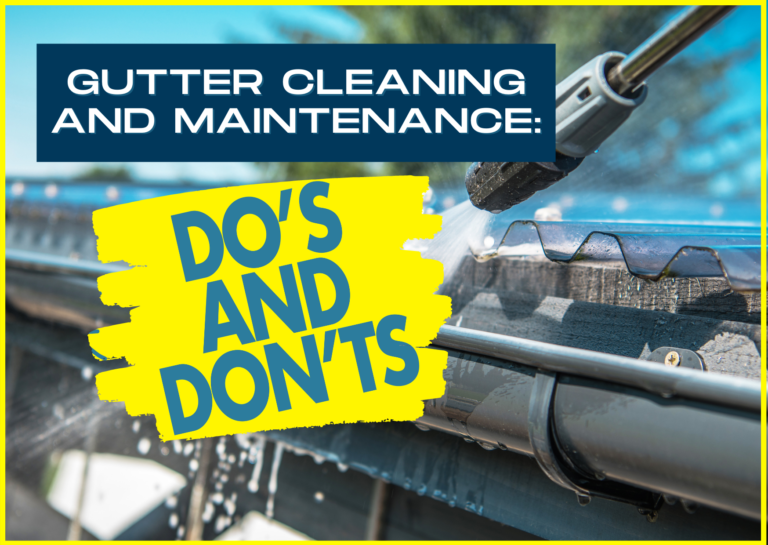House hunting? A crucial factor for deciding for or against buying a home should be your neighborhood! You would love to be in your dream house within a community of great architectural style, modern amenities, a playground, a sports community, and a shopping center nearby. You’d love a place with dedicated street spots for biking or moving around without a car, a green landscape of lush canopy trees, and easy access to public transportation.
All these sound truly ideal—until your next-door neighbors decide it’s fun to hold regular parties until the wee hours of the night or that it’s fine to park their vehicles in the wrong places. Worse, they might think you don’t mind property line violations such as building fences crossing over your lot or putting up political signs on the front yard!
All these neighborhood situations made the creation of Homeowner Associations imperative!
The Foundation for Community Association Research has reported that more Americans live in community associations now than ever before. According to the 2019-2020 National and State Statistical Review for Community Association Data, approximately 27% of homes in the US have homeowners associations, housing cooperatives, condominium communities, or community associations.
Among the 50 states, California has the greatest number of associations, counting up to 49,200, followed by Florida with 48,500 associations. Texas takes third place with 21,000 associations, then Illinois, North Carolina, and New York, with 18,800, 14,100, and 14,000 associations, respectively. Report for the previous year showed about 351,000 community associations compared to the growing 354,000 today.
Additionally, the Foundation has reported ratings of the significant majority (89%) of homeowners and condominium residents in the 2020 Homeowner Satisfaction Survey. Forty-nine percent (of homeowners and condominium residents) rated their overall experience as “very good,” 30% “good,” and 19% “neutral.” HOA has become a staple in the US house market since they give homeowners and residents an amount of control over their investment that they cannot do in non-community association areas.
Remember, however that while most homeowners and residents are willing to give up some freedoms in exchange for the convenience of living in community associations, some people do not like being told where they should park their cars, when to cut their grass, or how to follow protocols before painting their house. Even though most homeowners and residents would favor living in a planned community, homeowner associations are not for everyone.
So, what is HOA and what does it do?
Homeowners Association or HOA is a non-profit private organization established to manage and maintain a neighborhood, buildings like condominiums, townhouses, subdivisions, and planned single-family communities. It is an association of homeowners who have a common interest. Generally, HOA is run by its elected board of directors or volunteers who create and carry out rules and regulations for its members to obey and follow. According to the Community Associations Institute (CAI), there are 2.4 million community association board and committee members in the US performing 86.7 million volunteer service hours each year. Americans have accepted the importance of collective management in community living and how it protects life quality and enhances property value.
HOA formulates homeowner rights and obligations, and these are commonly specified in a document called the Declaration of Covenants, Conditions & Restrictions (CC&Rs), and the HOA’s Articles of Incorporation and Bylaws. CC&Rs are officially recorded and filed in your respective state. It determines the types of properties and structures are permitted on a lot. This includes square footage, set back, design approval, and landscaping requirements. Additionally, there are rules for the removal of trees and free-standing garages stated in CC&Rs. If you’re buying an HOA property, consider all building requirements and its overall cost. HOAs impose restrictions on the color of the paint you use, and some even demand all houses be of only one color.
In most cases, HOAs also establish rules for pets and other animals. For instance, some HOA might require dogs to be within a certain weight limit or even breed. Some prohibit livestock, chickens, and other farm animals in the area.
CC&Rs also allows the board of directors to collect fees from its members and impose monthly dues, annual and occasional assessments. The Community Association Fact Book, the value of homes in HOA has reached approximately $7.2 trillion, while $96 billion in annual assessments were collected in 2019. This shows the continuous effort in funding and increasing the percentage of homeowners in obtaining affordable housing. Details on what you must pay and how you must pay to vary depending on the community rules.

Typically, dues and maintenance fees cover snow removal, electricity, landscaping, trash removal, property taxes, pest control, personnel salaries, insurance policies, maintenance of swimming pools, tennis courts, roads, parks, and other public areas, and attorney fees. If you live in a condominium, your HOA fees may cover repairs for elevators, roofs, hallways, patios, and lobbies.
You may also find yourself paying for unexpected fees that will fall under special assessments. These fees are charged when the association has to make some major repairs or improvements like road repairs. Fees are not set in stone and could change due to inflation and other factors. So, be prepared and determine your budget.
The HOA can file a legal action against you for unpaid dues and get a grant from a judge for them to collect those. HOA can also get a lien on your home, which will eventually lead to the property’s foreclosure. You can write to the board of directors about your intentions to settle your unpaid dues and put in a good faith effort to cure your delinquency. Otherwise, the cost will substantially increase.
Understand the HOA fees before purchasing an HOA property. Doing this will help you decide and see if the property has a clean title. You can also check if there are outstanding because new owners can be liable for the previous owners’ unpaid dues in some states. Review the association’s governing documents and policies for your guidance and knowledge about your rights and obligations as an HOA member.
History
Homeowners associations and community associations have been continuously growing for the past few decades, but how did they start? Planned communities were originally formed in the mid-19th century by land developers who wanted to manage their common needs. However, it wasn’t until the late 1940’s that a planned community set off. Low-interest homes (where community rules and regulations existed) were offered to war veterans. Covenants were created to control people who could purchase properties.
In the 1960s, the Federal Housing Administration (FHA) supported HOAs by offering home mortgage insurance to build large-scale residential expansions. It rapidly grew and attracted more homeowners when federal mortgage rules were modified to include cooperatives and condominiums in the picture. HOA would then manage communities and shared common spaces that were originally assigned to municipal workers. More and more communities were set up and made HOA structure changed based on the homeowner’s preferences. Eventually, similar communities popped up, and real estate developers organized HOAs to maintain common areas and amenities. Over time, covenants have been amended to accommodate the rules of modern home ownership.
Purposes of HOAs
The main objective of HOAs is to preserve and enhance the homes within their area of jurisdiction. HOAs were created by the same real estate developers who built the neighborhood because they want to keep tabs on the community they built and ascertain that it continues to progress. Establishing a system of property rights and administering the business of the association is also included in the objective of HOAs. A small HOA may meet once a year to discuss upcoming projects or elect its board members, while a large-scale HOA might have to meet once a month to address homeowners concerns or approve a budget.
Benefits of living in an HOA
First off, HOAs are established to ensure that homeowners can have a great experience in community living. Here are some remarkable benefits of living in an HOA:
Stabilized home values
Some of the important factors that influence your home’s value are neighborhood surroundings, home size and usable space, and upgrades. As a homeowner, you must protect your investment and get good returns. When your HOA enforces uniformity on how houses and yards should look or be updated, this means your home value remains consistent. HOA protects your homes from bad neighbors who destroy and drag down homes’ value throughout the neighborhood. A desirable community can be a bright point for potential buyers. If you want to sell your property in the future, you can look forward to driving your property value higher within an HOA.
Community Engagement
You don’t often socialize with your neighbors in a non-HOA community, but with HOAs, you can build a sense of community. Strangers turn into neighbors and even friends in an HOA community. You won’t need to feel isolated or disconnected since HOAs give every homeowner a chance to pursue activities and interests in the community. HOAs hold meetings, welcoming activities for new neighbors, and social events that make it easy for you to connect to your neighbors. Some complex HOAs build committees and appoint homeowners who want to share ideas in creating memorable events and gauging each interest level. Conducting annual events keeps the community in touch and creates something exciting for homeowners and residents to look forward to.
Aid in resolving community disputes
A well-run Homeowner’s Association will help settle disputes between neighbors by addressing issues and ensuring they are resolved quickly. This is done by giving the homeowners involved a chance to meet and confer with the board. The board may assign other board members to help the parties reach an agreement. A settlement can be put into writing and signed by the homeowners and board members.
In worst-case scenarios, the HOA board will seek help from legal experts for lengthy and costly arbitration, thereby motivating the homeowners to settle their disputes. HOAs have clear dispute resolution policies to communicate to all members. Getting into a dispute could be messy and potentially lead to legal actions. With an HOA, disputes can be resolved without turning them into costly and time-consuming litigation.
Emergency services are offered
Accidents and emergencies happen, and it isn’t easy to deal with them on your own! HOAs can provide quick assistance when these things happen because the mission is to look after every member’s health, safety, and well-being. HOAs are expected to develop a master plan for disasters, crises, and emergencies common in the area. The plan includes standard procedures, instructions on handling debris, setting up all important contact information, and insurance information. HOAs also take the initiative to establish guidelines for how these situations are handled. Community education is part of their duty in informing all homeowners on what to do in the event of a crisis. As they say, it’s better to be proactive than reactive!
Why Homeowners Need to Follow the Rules
When you decide to be a part of an HOA, you responsible for certain rules and regulations. These things can help a community flourish and provide a common outline for everyone. The rules and regulations of an HOA vary per community or state, as contained in CC&Rs or Covenants and Restrictions.
So, what happens when you decide not to follow these rules and regulations or pay dues and fees implemented by the HOA? What would happen when you get sick and tired of what you should and should not do in an HOA? What if you don’t bring your trash at 6 PM and put the trash can out all night? What if you built metal fences when wooden fences were only permitted? This depends on how strict and vigilant your HOA board is, and the answer could be much worse than you can imagine. When you don’t adhere to the HOA rules, you don’t necessarily break the law. However, you may still face serious consequences like prohibitions using HOA facilities and even the inception of liens on your home.
Generally, when residents break the rules, it’s up to the HOA board to notify them. First, a warning letter or notice is issued. Next, HOA can impose fines for repeat offenders. Then, when owners refuse to pay the fine, the penalties add up. This would result in the suspension of rights and privileges. Lastly, if the issue escalates, HOAs can put a lien on your property before taking the case to court.
10 Most Common HOA Violations
Violations occur by accident or simply when homeowners and residents refuse to follow the HOA rules!

Here are the most common violations in a homeowners association:
1. Overgrown Landscape
Homeowners of townhouses and single-family homes who fail to remove weeds from, let their grass grow unkempt, and leave trash in their yard will most likely get a notice from the HOA board. This can be an eyesore to the community and possibly affect the property values in the area. HOAs have bylaws stating the need for residents to keep their yards be maintained and kept free from weeds and debris. This would also include keeping driveways and sidewalks free from shrubbery overgrowth and overhanging limbs of trees. Some HOAs will limit the types of plants and trees and where they can be planted. Additionally, failing to sod your lawn can mean a violation of the HOA rules.
Generally, after receiving the notice and not doing any effort to change your yard may result in HOA charging you for this violation. You have the right to a hearing, but if you neglect attending it, the HOA can take the case to court, which would lead to collecting fines. For reprehensible cases, the HOA can take further legal actions, and the fine would be larger.
Avoid violating HOA landscaping rules by being mindful of the following:
- The types of bushes and trees the HOA allows
- What color mulch you should use
- The allowable height for bushes and shrubs
- How low and long boughs and limbs on a tree should be
- How frequently you should cut the grass
- How often you should water your lawn based on a mandatory watering schedule
- Bare spots in yards
- Filing for application for construction of new beds
- Discarding compost, yard waste, brush, and other landscaping items on any common areas
2. Illegal rentals
One way to protect the community’s integrity is by limiting the homeowner’s capacity to their home. It may seem like a great way to bring in some money, but it may go against your HOA standards in keeping the property values. Rental restrictions promote neighborhood stability, avoid move-ins and move-outs, and prevent compliance violations (of renters). Some HOAs do not put restrictive rules against renting out homes, but this depends on the state’s policies. In condominium projects, guidelines as to how many renters are allowed are established. Some HOAs allow rentals but only to a limited number. Now, if you rented out your property without the HOA approval, then you’ll be asked to comply with the policy or pay a fine for each day of your noncompliance. In some cases, the homeowner and unapproved renter will be fined, and if they fail to comply, the association can file a lawsuit or evict the unapproved renter.
If restrictions exist within your HOA, then it knowing them would help you avoid committing this violation. Two common rental restrictions would be:
- Limits on the total number of rentals within a development
- HOA requiring new owners to live in the property for a specified time before renting it out
Review the rules for renters like application for HOA approval, submission of their information, and whether the HOA board can evict renters or not. Adhere to these policies, maintain the property, and know the renters’ approval procedure.
3. Overly-exposed garbage and recycling containers
Trash cans, recycling bins, and other garbage containers stationed in the wrong area are among the most common violations in HOAs. HOA governing documents would specify that garbage and recycling containers should not be in public view. This means homeowners should not place these bins should be completely hidden from the street view. Most HOAs want to achieve an attractive look in their neighborhood, and trash bins are usually not part of it. This ensures the curb appeal no matter where the property is located. It also helps with pest and animal control. This will keep wild animals from rummaging for food in the trash.
If you are caught violating this rule, several notices (courtesy, certified, and fine notices) will be sent out. Some HOAs may even enter your property to correct the violation themselves.
Watch out for the designated trash pick-up days. You can get a violation ticket for putting your trash containers too early or too late. You may use privacy screens for trash containers but be sure to get approval for it. Ask for a variance for trash rules if you find it difficult to comply with the existing rules.
4. Irresponsible pet ownership
A pet is considered a family member to many, and it only makes sense for HOAs to allow pets in the neighborhood. Some HOAs have a “no-pet policy,” but if your HOA is pet-friendly, learn the rules about keeping a furry companion in your home. Generally, HOAs can dictate pets or enforce pet limits, but these would still vary from association to association. HOAs may limit the number of pets in a household, impose a weight limit for dogs, allow certain dog breeds only, or require your pets to be spayed or neutered.
What happens when you violate the “no pet policy?” HOA can legally have your pet removed. Such policy is rather common in condominiums than townhouses or single-family homes. How about emotional support pets or service animals? Even if an HOA prohibits pets or animals, there is an exception to this. According to the Fair Housing Act, HOAs must permit people with disabilities to have animals provide them assistance or emotional support. In this case, the HOA has the right to ask for certifications or documentation from the homeowner.
The HOA board can file a lawsuit against homeowners who violate HOA pet restrictions, fine them, and cite contempt of court when things get out of hand.
How do you avoid violating the HOA pet restrictions?
The first tip would always be to read the rules. Before you purchase a condominium unit or an HOA property, clarify pet ownership regulations to determine if the community is indeed a good fit for you and your pets.
Follow the proper etiquette when it comes to animal waste. Be sure to pick up and clean after your dog and dispose of waste properly. Avoid too much barking or pet noise. While no one expects dogs to keep quiet 24/7, constant barking and loud noises will surely bother the neighborhood. Find out what keeps your pets from making loud noises and seek remedy for it immediately. Lastly, take responsibility for cases when pets cause injury, damage, or disturbance to your guests or neighbors.
5. Smoking in non-smoke areas
Another common complaint which HOAs face is homeowners dealing with the nuisance of secondhand smoke from their neighbors. That is why many HOAs respond to this complaint by going completely smoke-free. HOA board have the authority to establish smoke-free common areas like pools, tennis courts, clubhouse, meeting areas, and laundry facilities but smoking in the unit owners dwellings. Some HOAs also place a designated area for smoking. A written complaint and a log of incidents may be issued to you when breaking smoking policies. However, if the aggrieved party finds this problem persists, it can lead to fines and even litigations, which would then cost offenders more. To avoid this situation, a smoker should know where the rules apply. Consider that the smoke drifts everywhere, so it’s always better to smoking from a certain distance (from common areas).
6. Loud or noisy
Noisy neighbors can be a real headache for homeowners in the area and to the HOA board. It can be anything from early birds lawnmowing at 5 AM, party animals playing music all day and night, children screaming and throwing tantrums throughout the day, to loud instruments played in the garage. Nowadays, it’s almost impossible for HOAs not to establish rules about nuisance. One of the most common nuisance complaints concern parties. When there’s excessive noise, neighbors complain, and the offending neighbor will end up in conflict with them.
When there is a complaint, noisy neighbors are given a warning as early as possible. If the bad neighbor breaks the policies of HOA rules, then an official violation notice is given. HOA may try to mediate the conflict between neighbors, but when all efforts do not work, HOA can take further steps. They can file a lawsuit or have the offending neighbor evicted. All homeowners and residents need to avoid such a conflict to follow the rules or noise ordinances. HOA may prohibit loud noise or certain activities at specific times (e.g., between 10 PM to 7 AM) and prohibit neighbors from interfering with things you enjoy. You have to read the governing documents to go into detail since each HOA its policies.
7. Untimely holiday decorations
If February has come and you haven’t gotten around taking down your Christmas decorations, you will likely get a notice from your HOA board. Typically, HOAs have a guideline about the appropriate time to put up and take down holiday decorations. HOAs would establish a rule allowing homeowners to decorate their homes a month before Christmas. You usually have to remove them two weeks after. Disrespectful, derogatory, and inappropriate holiday decorations will have the homeowner fined and have decorations banned in the property. This ensures everyone in the neighborhood feels comfortable and celebrates festivities without someone ruining them because of complaints. HOAs can also set up rules on your decorations’ size and even go as far as limiting colors to establish uniformity in the neighborhood. Noisy decorations with super bright light may cause a nuisance to the next-door neighbor and may result in a fine for the homeowner. In extreme cases, authorities are called in to intervene to have decorations cleared out.
As HOA should remind homeowners about the rules, it goes without saying that homeowners should also ask for updates or any changes to these rules before putting up decorations. Depending on how active the HOA board is, inspections are scheduled to let the community members know what they can and can’t do for the holidays. Additionally, one has to understand the HOA’s fire and safety policies. You can choose a flame-resistant Christmas tree and let it stand away from fireplaces, candles, and other fire hazards. Again, avoid violations by checking the rules and don’t let holiday decorations get you into trouble.
8. Unapproved house design and architectural changes
As mentioned, an HOAs goal usually involves maintaining consistency and uniformity in the appearance of the neighborhood. This is why even the tiniest detail in the property structure becomes a big issue. HOAs want to keep a dignified atmosphere so, painting your house with freakish colors because you think the original color is boring– will never be a good idea. But how about renovations and other home modifications? You must submit plans to the HOA’s architectural committee before starting the construction. Know the applicable rules when it comes to setbacks, and height, and size limitations. If you don’t seek approval from your HOA board before starting a project, you might be forced to stop construction progress or redo everything completely. Condominiums have strict requirements for home modifications since great portions of condominiums are part of the common areas.
When it comes to landscaping, rules and regulations vary greatly from community to community. For instance, if the community is flourishing suburban, there might be guidelines on specific trees, plants, or landscape material used in the modification. On the other hand, if a community is in a rural area, its HOA may require homeowners to maintain the landscape but won’t interfere with the other landscaping details. So, make your expansion or modifications comply with HOA rules and regulations before commencing.
9. Improper parking
Parking violations might seem like a minor issue to some, but it’s one of the most common problems HOAs have. It can become a hassle to many homeowners and residents that may be a source of tension within the community. Some residents would have their family, friends, and guests over and have their cars parked all jam-packed in front of the house and next-door neighbor’s property. Some guests park their cars overnight. Conversely, some residents park their vehicles on guest spots, streets, and even lawns.
HOAs commonly prohibit certain types of vehicles in the neighborhood, regulate residents’ parking location, and determine when homeowners can park their vehicles in a specific area. Depending on the community and its state laws, some HOAs can revoke owner privileges or tow vehicles when parking violations happen. For first-time offenders, a parking violation notice is usually sent out to them. If they become repeat offenders, they could be fined. The HOA board would usually give them a warning and a 96-hour lead time before towing the vehicle. Common areas where homeowner vehicle parking is not allowed include handicapped spaces, guest spots, fire, hydrant access, and loading zones. HOA parking rules exist to maintain the aesthetics of the neighborhood.
HOA Wants Those Gutters Fixed!
A leaky roof and clogged gutter can pose a serious problem that may lead to structural damages. When ignored, the cost of repair would be much greater than regular maintenance. When this happens, expect a letter, or notice from the HOA board. This letter may contain a warning or information of any fines. For residents in single-family homes or townhouses, the HOA board would demand that you fix your deteriorating roof and gutter as the damage would cause cosmetic issues.
Learn the specific HOA rules for your roofs and gutters and ensure full compliance to avoid violations and fines. If you need gutter contractors to help you with gutter maintenance and repairs, always choose a well-regarded, experienced, and properly accredited gutter company. Settling for anything less could lead to poor work outcomes and affect the value of your home!
ALSO READ:
Gutter Cleaning and Maintenance: The Dos and Don’ts
10 Signs It Is Time to Upgrade Your Gutters
Gutter Services in Tennessee







